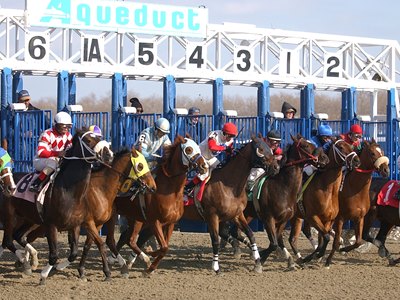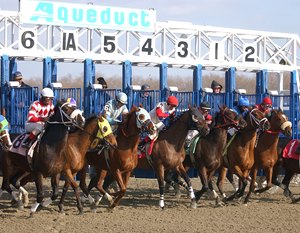Study Calls for Changes in New York Racing Industry


A state government-commissioned study of the gambling industry in New York calls for major changes to antiquated racing regulations and laws. The proposed changes aim to end decades of unproductive infighting by stakeholders in the racing industry and smarter ways to devise how everything from pari-mutuel revenues are distributed to how many days a year a track offers live racing.
The report by Pennsylvania-based Spectrum Gaming Group, which was due to be released last year by the New York State Gaming Commission, also floats everything from closing down Aqueduct Racetrack for a month during its winter meet to consideration of a statewide consolidation of five regional off-track betting corporations that are owned by local governments.
Gaming Commission officials had said the study would be sweeping in nature that would help guide policymakers on decisions about whether to expand into new gambling ventures or reexamine rules guiding long-struggling existing players in the industry, which the state relies heavily on each year for tax revenues.
A major takeaway from the Spectrum report was its estimate that a statewide sports betting program, including a new mobile betting component, would generate between $816 million and $1.14 billion in annual gross gaming revenues.
Sports betting is already permitted at New York's commercial and Indian casinos. Gov. Andrew M. Cuomo and the state legislature both have their own, sharply different ideas on how to legalize the far more lucrative side of sports betting: via mobile means in which bets could be made from anywhere in the state on smartphones or tablets.
What role, if any, the racing industry might have if mobile sports betting is permitted is uncertain. The sides are trying to resolve the matter as part of state budget talks; the budget is due March 31.
On the horse racing sector, the Spectrum report said how money bet on races gets distributed to various stakeholders, as well as governments, "resembles a game of Whac-a-Mole in which endless challenges pop up."
The industry itself has seen near-constant internecine fighting. "The New York racing entities view each other as competitors, sometimes seeking legal changes that may help one whole reducing revenues or profits for another,'' the report said.
The report urged that revenue from all pari-mutuel wagering "should support live racing" and that there must be new industry incentives "to grow wagering statewide" and that "a healthy live-racing product is integral to maximize the industry's economic impact to the state."
The report delved into the complexities and politics of racing in New York. It discussed the financial hit still being seen by the closure of New York City Off-Track Betting Corporation, which happened in 2010 at a time when its annual handle was running at about $650 million a year.
The impact is seen partly in one number: a 35.4% decline in total wagering at all tracks and OTBs in New York from 2010 to 2018, compared with a 1.6% national handle drop.
The racing industry faces growing roadblocks, from the costs of doing business in high-tax New York to "issues involving treatment of horses and equine deaths." Questions remain about equine health challenges, what the report called racing's "social license,'' which is defined, partly, as the "societal acceptance" of an activity like racing.
The racing industry has a $3 billion annual economic impact in the state, the report noted.
While there are many changes the state should consider to bolster the racing industry, Spectrum said the industry itself has a major role to play, if it can end the decades of distrust. "Given the downward trends for the racing industry, instead of looking at capturing other industry participants' market share to keep margins up, or discussion of why things can't be done, the New York racing industry needs to collectively examine change in light of what can be done to benefit the state and the stakeholders,'' the report said.
The report calls for a more systematic, data-driven way to determine a tracks' annual racing date requirements. It noted that recent changes in New York race dates have not had a "severe negative impact" on things like purses and breeders' awards, but that a "large-scale immediate change" could have a lasting set of negative impacts that harms the breeding industry and the number of horses participating in New York races.
The report said something has to be done about the relatively high number of required racing days in New York, and that the state should start with a new "analytical approach" to determine racing day formulas. The current approach, which involves tracks and horsemen negotiating dates that are then approved by the Gaming Commission, is a decades' old practice.
"Decades ago, racing faced less competition, and the breeding industry was producing many more racehorses. As noted in the report, there exist informal mechanisms currently, but they should be more transparent and formalized,'' it said.
The report said closing Aqueduct for one month during its winter meet would address a number of issues, including a recognition that bettors prefer to bet more on racing during other times of the year as reflected in the fact that Aqueduct's winter meet has the lowest handle and—due to either the weather or quality of horses—the higher fatality rate per 1,000 starts than the other two NYRA tracks.
The report noted the many factors that have to be considered if race days are modified statewide. "Of course, there would be an impact on purses and breeders' awards and an effect on both horse owners and breeders. But the patrons' needs and wants, the economic impact of the state, and racetrack viability also deserve consideration,'' the report said.
The Spectrum report also suggested:
- Possible major restructuring of the state's five OTB corporations, which are owned by local governments in the different regions. It said a single OTB might be considered by the state, or perhaps a system in which the OTBs are run by racetracks.
- Changing antiquated payment schedules that distribute money on complex formulas that involve tracks, OTBs, the state, and others, and reexamine the pari-mutuel tax structure based on a model dating back to the 1940s.
- Raise the state's "market origin fee" from 5% to as high as 6.5% on multi-jurisdictional ADW companies, which take New York bets but without many having to comply with many of the rules and laws that put New York-based betting outlets at a disadvantage.
- Consider permitting tracks and OTBs to take bets on other sports. It said a "minor" modification to the state's pari-mutuel wagering law could expand the current horse betting only restriction to include all sports being taken by tracks.
